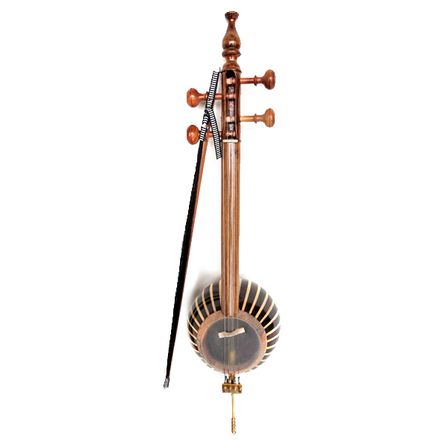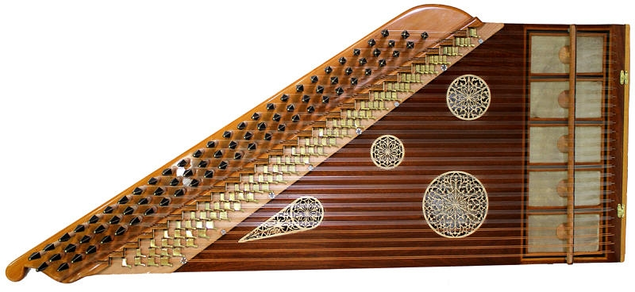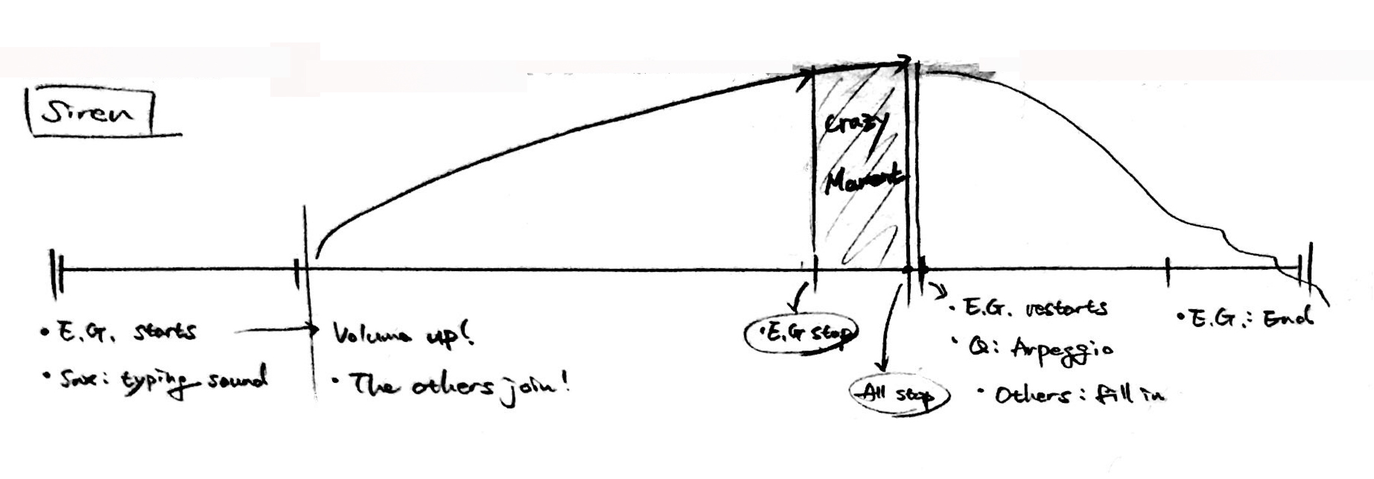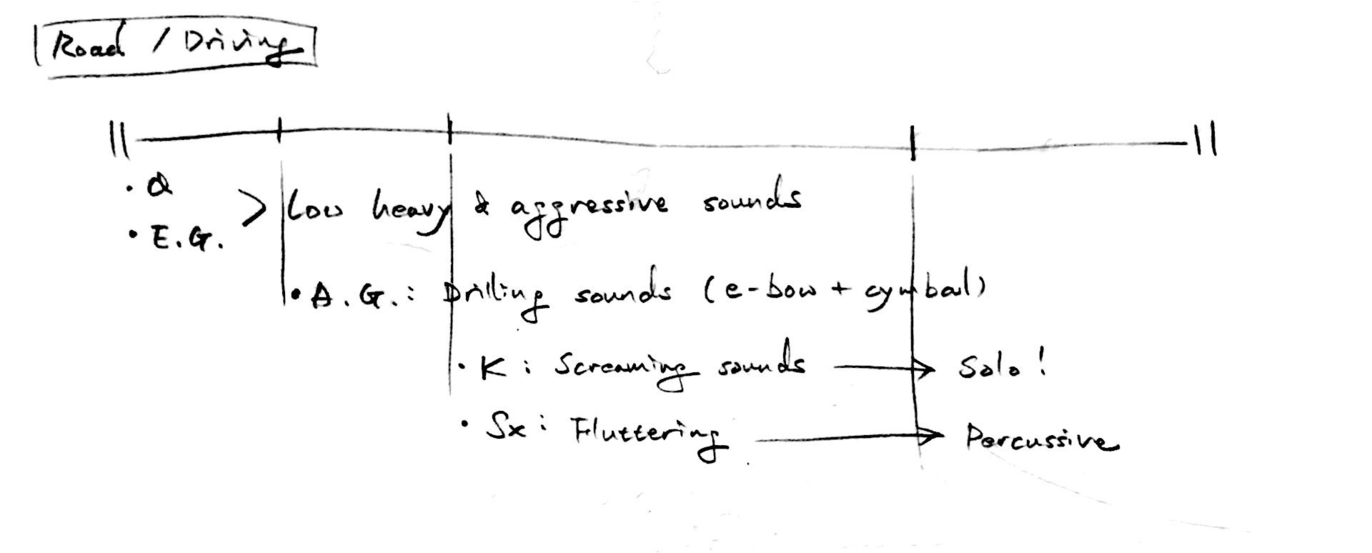Set a project → Search musicians and identify their style and skills → Composing → [Rehearsal & discussion → Edit arrangement] → Repeat [ ] → Outcome: Concert & Recording
General Process
In this chapter, I delineate the process of the band project “PAN” and its outcome. The project has a general process which is an extension of “Hermeneutic Circle” that works by developing 1) pre-knowledge through 2) experience to 3) new knowledge and deeper understanding, which will influence 1’) again and therefore forms a circular system.
The hermeneutic circle is a prominent and recurring theme in the discussion ever since the philologist Friedrich Ast, who was probably the first to do so, drew attention to the circularity of interpretation: “The foundational law of all understanding and knowledge”, he claimed, is “to find the spirit of the whole through the individual, and through the whole to grasp the individual”. Friedrich Schleiermacher in a lecture of 1829 adopts as a principle the notion that the same way that the whole is, of course, understood in reference to the individual, so too, the individual can only be understood in reference to the whole.1
At the beginning of the project, I start by searching the musicians and identifying their styles. Since improvisation is a prominent element in my project, each musician’s individuality is reflected strongly in the music. Therefore, searching and identifying a musician is always the gateway to the project. I add musicians one by one like building blocks. Through this process, I adjust and modify the direction of the music and the concept of the band.
In my composing process, many times, a specific sound or technique is influential and inspirable to the motive of the composition. I get an idea and write a piece by incorporation internal and external inspiration rather than composing completely structured music. For example, I request a certain sound or a certain playing style for the musician to discover and produce. The musicians then explore the possibilities in their instruments and figure out the boundary of potentialities. Sometimes a new invention of sound emerges and it brings a new creation to the music. The other way around, I get an idea from a sound from the musician that develops to the motive and composition. Consequently, the music contains enough space for the musicians to have their own explorations and apply their interpretations. This flexibility allows the musicians to alter and develop the composition in various ways while they follow the frame of the composition.
Since it contains improvisation as its core, each rehearsal results in different versions of the composition. It is an outcome of action and reaction, the interaction between musicians rather than accident and coincidence. These elements from variations suggest new inputs and they are reflected in the composition yet again. This process is repeated during the whole rehearsal process, which gives the band opportunities to search for and adjust to the most relevant structure and arrangement. Furthermore, the openness of the composition allows the musicians to bring a new element constantly. It keeps a piece interesting and makes every rehearsal come alive.
Rehearsal process in the band PAN
This is a project during my Erasmus exchange in Gothenburg, Sweden. The master program in Gothenburg is a combination of improvisation and folk music. This opportunity allowed me to encounter not only new improvisers but also amazing folk musicians from other cultures.
Through this program, I encountered another master exchange student Vít Beneš who I mentioned in the previous chapter. We found a common topic and interchanged our ideas: the conceptual idea of the composition in which each instrumental role has its own independent time, groove, and position. These are then blended into a one-sound by communicating and interacting in an ensemble. At that time, my main focus was improvised music which has a compositional concept with alternative sounds. In consequence, I set a project that uses this concept which is a compound of aspects of free improvisation and composition. In addition, since the sound concept I have is connected with folk music, I added folk musicians to the project to apply alternative sounds to the actual folk instruments and emphasize natureous sounds. Adding folk instruments also produced an effect that is a contrast between the folk sound and Beneš’ distinctive electric guitar with effect pedals.
In the beginning, the band started as a trio of me on saxophone, Beneš on electric guitar, and Shafeeq Alsadi on “qanun” which is a Middle Eastern string instrument. According to the Encyclopedia Britannica, the qanun is a trapezoidal zither used in the Middle East, North Africa, and parts of Asia. It is a kind of psaltery and may have upwards of 70 strings, usually in courses of three.2
By the influence of the Master’s program’s ensemble project “Trinity” in that autumn, I first built the core sound of the band as a trio. The Swiss psychiatrist Carl Jung said, “The meeting of two personalities is like the contact of two chemical substances: if there is any reaction, both are transformed.”3 And Karl Menninger, the American psychiatrist said, “With Three a new element appears in the concept of numbers. I-You: The I is still in a state of juxtaposition toward the You, but what lies beyond them, the It, is the Third, the Many, the Universe.”4 Those words show the features of a trio that contain stability and flexibility. These characteristics also reflect on the music and the band setup. Since my trio had democratic decision-making in an ensemble process, each member had an equivalent value and it generated three different situations. 1) Each of us has a different direction. 2) Two of us claim different directions and the last one supports one of them. It produces two layers which are one major idea and another idea which is minor. 3) All of us agree with one motive. Trio offers the minimum number of proper decision-making while it creates diverse situations. Beneš took the role of electronic sound and ambience, my saxophone primarily had a front role, and Alsadi’s qanun brought more colors and details to the music with its unique timbre and distinctive playing style.
First, we started the journey of the band with a free improvisation session to figure out what chemistry we would have. The whole sound of the trio contains many contrasting elements. Beneš’ guitar has a heavy and massive electronic sound that has an artificial characteristic. He often takes the low register and fills the room that gives an effect as bass as well. On the other hand, Alsadi’s qanun is very sharp, colorful, and busy. Since the strings are metal, it has a dry sound with an attack that gives bright and clear temper. Also, it makes a lot of layers from the busy playing style with the structure of the instrument that has courses of three strings. The saxophone is a wind instrument that already gives a different character compared to string instruments. The airy sound and the middle range of the tenor saxophone in between two other instruments create a distinguishable room sound meanwhile it also generates a certain role as a bridge to blend all different sounds. Furthermore, since I use many alternative sounds, it produces different types of tensions in the music.
Afterward, as I considered adding more layers in the music to make it articulates more textures and small details, I came to add two additional members, Joel Haag on acoustic guitar and Farshad Saremi on “Kamanche”. I encountered Haag at the free improvisation jam session at the Gothenburg jazz club Brötz. Since then, we had rehearsals as a duo regularly and exchanged musical ideas. Especially, his acoustic guitar was very experimental with an unconstrained approach and a lot of tools such as bow, e-bow, cymbal, and pins. Kamanche is an Iranian string instrument. The word kamanche means “little bow” in Persian. It is an instrument with 4 or 5 strings and a bow like a violin or a fiddle. In 2017, the art of crafting and playing with kamanche was included in the UNESCO Intangible Cultural Heritage Lists of Azerbaijan and Iran.
Kamanjā, also called kemanche, or kamānche, a stringed instrument of the fiddle family prominent in Arab and Persian art music. It is a spike fiddle; i.e., its small, round or cylindrical body appears skewered by the neck, which forms a “foot” that the instrument rests on when played. Measuring about 30 inches (76 cm) from neck to foot, it has a membrane belly and, commonly, two to four strings tuned in fourths or fifths. The musician, who plays while seated, rests the foot of the instrument on his knee.5
Since other string instruments in the band were plucked ones, the texture and articulation from the bowed instrument expanded the expression of the band sound. The mechanism of the bowed string instrument had the advantage to use blue notes naturally between western scales. Particularly, with the distinctive timbre of the kamanche, it produced a unique sound. Also, because of the similar range of the register, it blended well together with tenor saxophone when we played an interactive melody or theme. Expanding the size of the band added more volume, dynamic, textures, and colors. Particularly, filling the space in the music by weaving with additional noises and effects created natureous atmosphere.
After the band formed five members, I brought a composition that has a clear concept and theme. The music sheets were notated by graphs, signs, and specific comments. I wrote each piece based on a specific theme that included two different meanings, one is on the surface and the other is immanent. Many of the themes were inspired by particular sounds or techniques from my saxophone or other band members. Based on the information of each musician I obtained from the previous rehearsals, I requested to the musicians a specific sound or role that is related to the theme. The musicians had active investigations to discover a specific sound in line with my request and it brought a new discovery. In this process, we also exchanged sound concepts and ideas and influenced each other by imitation. Although there was not any written part in the pieces (except “Wave”), many of them had arrangements to give clear concepts and directions to the musicians.
In this project, I aimed to produce improvised music with a compositional approach or composed music contains improvisational factors. The compositions consist of natureous elements that are alternative sounds and an unconventional composing method. I focused on the whole sound of the image, atmosphere, and storytelling that includes emotional reflections rather than mathematical and theoretical details of note, chord, rhythm, tempo, time, and so on. In the composition, even though it included many contemporary elements as an important component, I intended to give a clear vision and storytelling to the listener and attempted to fabricate it as an audio-movie. And all the compositions formed one major theme of the whole album like an omnibus.
Since the two guitarists were familiar with free improvisation, it was smoother for them to comprehend this concept. Their perception was adding a basic frame on free improvisation as a tool to give a guideline. We agreed that the combinations of irregular components create intensity and fascination. Meanwhile, it had a different process for the two folk musicians. Because they were not used to music consists of alternative sounds, it took some time to understand the whole structure of the sound. But both musicians' understanding of flexibility and variability made it easy to follow collective improvisation spontaneously.
Product
I Had a Dream is PAN’s first album which is recorded in March and released in July 2020. Each track has a theme that contains specific sounds as a core and presents a significant image of the music. The direct connection between the title and sound allows the listener to comprehend the music intuitively. The sounds in the music focus on timbres, textures, and expressions as a tool to weave the soundscapes and atmosphere.
In the following sections, I will introduce and analyze samples of the tracks in the album.
Siren 'Sopor'
This piece was started with the idea of the siren sound, specifically with the image and atmosphere of Christopher Nolan’s movies such as Inception, The Dark Knight, and Dunkirk. I got the concept of the layers of the sounds in different registers. In this piece, the bottom sound from the electric guitar is prominent to create the atmosphere of the music. I discussed it with the guitarist Beneš and he discovered massive wavy sounds and effects by using effect pedals and turning the guitar tuning knobs. The acoustic guitarist Haag actively used a bow to add more layers and textures. I applied the sound imitating typing machine in the intro to create a movie-esque quality.
Since this piece contains more arrangements, it shows a structured form: intro, body, and outro. The dynamic of the music is developed constantly until the climax by collective improvisation. There is no given tonality however the sound from electric guitar indicates a specific pitch. It generates a contrast between the pitched sound of the electric guitar and the non-pitched sounds of other instruments.
Bricks 'Battery'
This is the piece in which I apply the concept of watchmaking that I mentioned in the previous chapter. The basic framework is that each instrument repeatedly plays a role of its own, like the parts of machinery. Musicians have independent roles meanwhile they are connected by interaction. During this process, the musicians affect each other and develop their phrases or patterns gradually. I applied a simple arrangement that musicians start playing in the order and end in the opposite order. I put the kamanche separately like in a parallel world. It has a different role that plays linear melodies, unlike the other instruments.
The general atmosphere of this music aims at the industrial sound. The theme is about the parts of the machine. In the progression of the music, each part gets broken and runs out of battery gradually. The music starts with the groovy electric guitar that decides the rhythm of the music. Particularly, in this piece, I used only slap tonguing to articulate groovy patterns effectively. Haag used the muted string sounds actively on his acoustic guitar that blended well with the other sounds. Alsadi created a special rubbing sound with the hair of the bow that produces an industrial vibe effectively.
PAN - Bricks 'Battery' (I Had a Dream, 2020, Creative Sources)
Road 'Driving'
Before I wrote this piece, I was interested in Alsadi’s new sound which he discovered during the rehearsal. This is a kind of dense and hard tapping sound through the pickup installed on his qanun by scratching or rubbing the wooden part near the pickup with some metallic tool. I got a motive from this sound and requested Beneš to produce the sound that has a similar temper. Based on this, I got another idea from the rehearsal with Haag that his use of a cymbal and electric bow generates the sound of a chainsaw. To have a similar sound concept and blend with them, I chose flutter tonguing and growling as the main sound. I also requested Saremi to produce rough textures with aggressive playing.
In the composition, I set the electric guitar and qanun as a ground sound. The electric guitar takes almost the role of bass while qanun moves around with various sounds including the tapping sound. On them, the chainsaw sound from the acoustic guitar adds intensity and high register. Saxophone and kamanche join later with a similar feature of the texture and expression. This piece consists of collective improvisation of specific sounds that are prepared to articulate the theme transparently. The music describes a scene of rough driving with diverse textures, articulations, and dramatic development.
PAN - Siren 'Sopor' (I Had a Dream, 2020, Creative Sources)
PAN - Road 'Driving' (I Had a Dream, 2020, Creative Sources)




